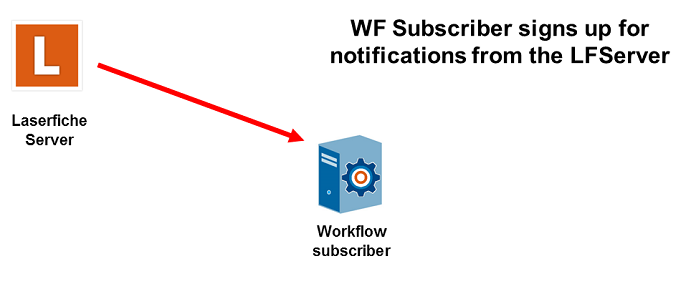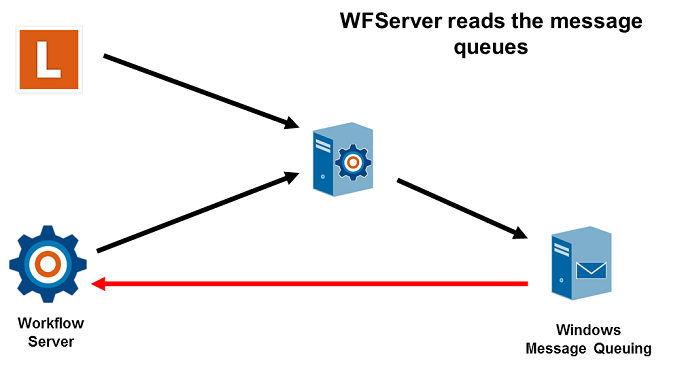The following diagrams provide a detailed overview of how Workflow operates.
Diagram 1: Workflow Designer and Server Interaction

Diagram 2: Laserfiche Server and Workflow Subscriber Interaction

Diagram 3: Workflow Subscriber Evaluation

Diagram 4: Workflow Subscriber and Windows Message Queuing Interaction

Diagram 5: Workflow Server and Windows Message Queuing Interaction

Diagram 6: Running Workflow Rules

Diagram 7: Business Processes

Note: Workflow must have a Workflow Web Service running for client applications to start business processes.
Primary Components
The primary components are:
- Workflow Designer: The component you will interact with the most. This component is where you build and publish your workflow definitions.
- Workflow Server: The component that runs workflows. The Workflow Server receives notification from the Workflow Subscriber when a change is made to a Laserfiche entry that satisfies a starting rule or wait condition. See Choosing a Workflow Server.
- Workflow Subscriber: This component acts as a link between the Workflow Server and the Laserfiche Server. The Workflow Subscriber receives notification from a Laserfiche Server when a change is made to a Laserfiche entry. It evaluates the event to determine if a starting rule or wait condition is satisfied. If so, the Workflow Subscriber notifies the Workflow Server.
- Workflow Web: A website that allows you to view Workflow definitions and search for workflow instances. This component is a lightweight alternative to the Workflow Designer if you only need to view workflow information.
Note: Workflow Web Designer has been retired and is no longer available In Workflow 11.0.1 and later.
![]() Show me a diagram of these concepts.
Show me a diagram of these concepts.
Administrative Components
The administrative components are:
- Workflow Administration Console: This console provides a variety of tools that let you monitor and modify information for each Workflow Server the console is connected to. For example, you can see a list of your currently running workflows and business processes, view a history of when workflow and business process modifications were made, monitor starting rules and wait conditions, update your Workflow Web service, and configure security settings. This console is an optional install.
- Workflow Configuration Manager: This manager guides you through the configuration process for your Workflow Server, Workflow Subscriber, monitored repositories, e-mail servers, trustee directories, and Workflow Web service (if installed).
- Workflow Server: Enables you to configure properties associated with the Workflow Server, such as login accounts and the SQL database that will store Workflow data. This must be configured before using Workflow. More information.
- Workflow Subscriber: Enables you to configure properties associated with the Workflow Subscriber. This must be configured before using Workflow. More information.
- Monitored Repositories: Enables you to configure repositories the Workflow Server can interact with. You can also specify the repositories to which each Workflow Subscriber will be registered. This must be configured before using Workflow. More information.
- Email Servers: Enables you to specify the SMTP servers through which the Workflow Service will send e-mails. More information.
- Trustee Directories: Enables you to specify the trustee directories that will be accessible to Laserfiche Workflow. More information.
- Workflow Web Service: Enables you to start business processes from the Laserfiche client applications. More information.
The Workflow SDK is a toolkit for customizing and extending the functionality of the Workflow product suite. Using the SDK, users can create their own activities for use in Workflow and integrate directly with the Workflow Server (including the ability to start workflows programmatically).
You can install the Workflow SDK from the Custom Setup page in the Workflow Installation Wizard.
The Workflow SDK includes:
- The API for interacting with the Workflow Server
- The Activity Proxy Generator
- Sample projects for custom activities (For more information see the Building Custom Activities in Workflow (C#) or Building Custom Activities in Workflow (VB.NET) white paper on the Laserfiche Support Site.)
- Visual Studio project templates for creating custom activities (C# and VB.NET)
- A sample Web service for starting workflows and business processes
- A sample console application for starting workflows and business processes
More information about the Workflow SDK:
